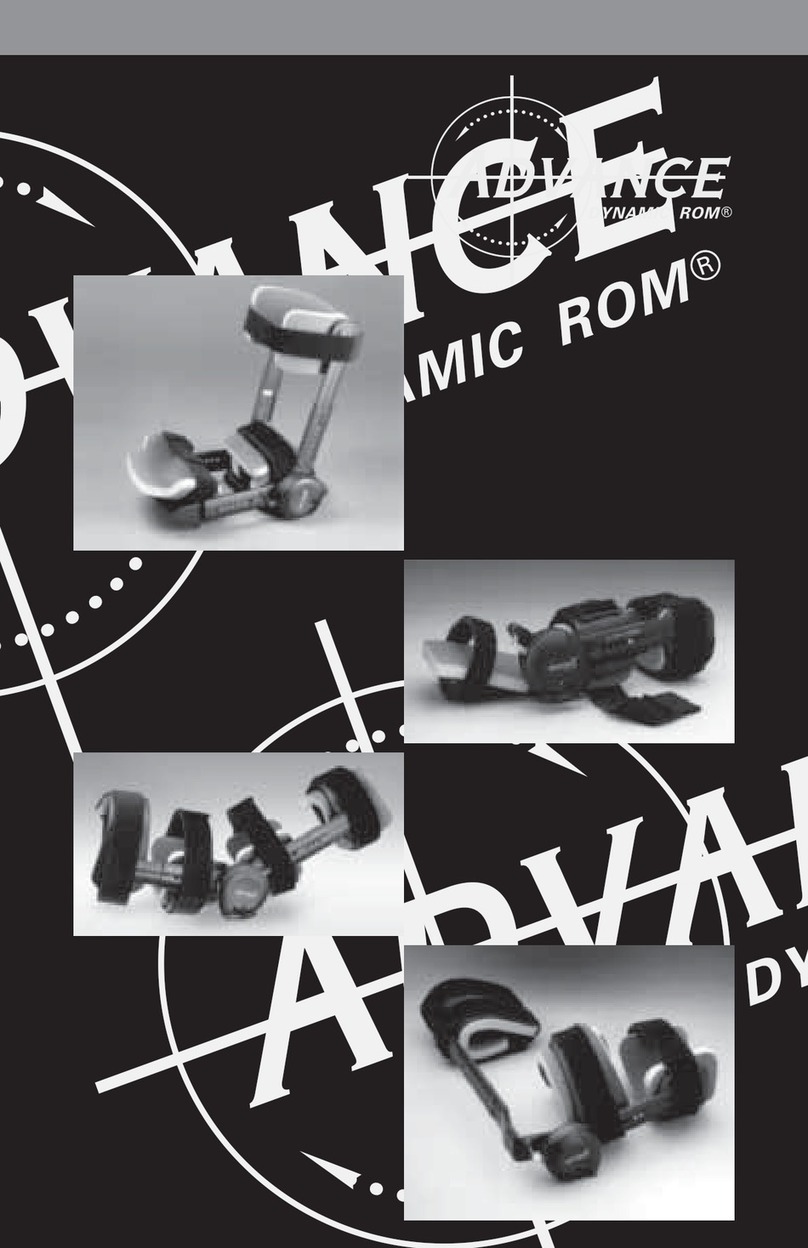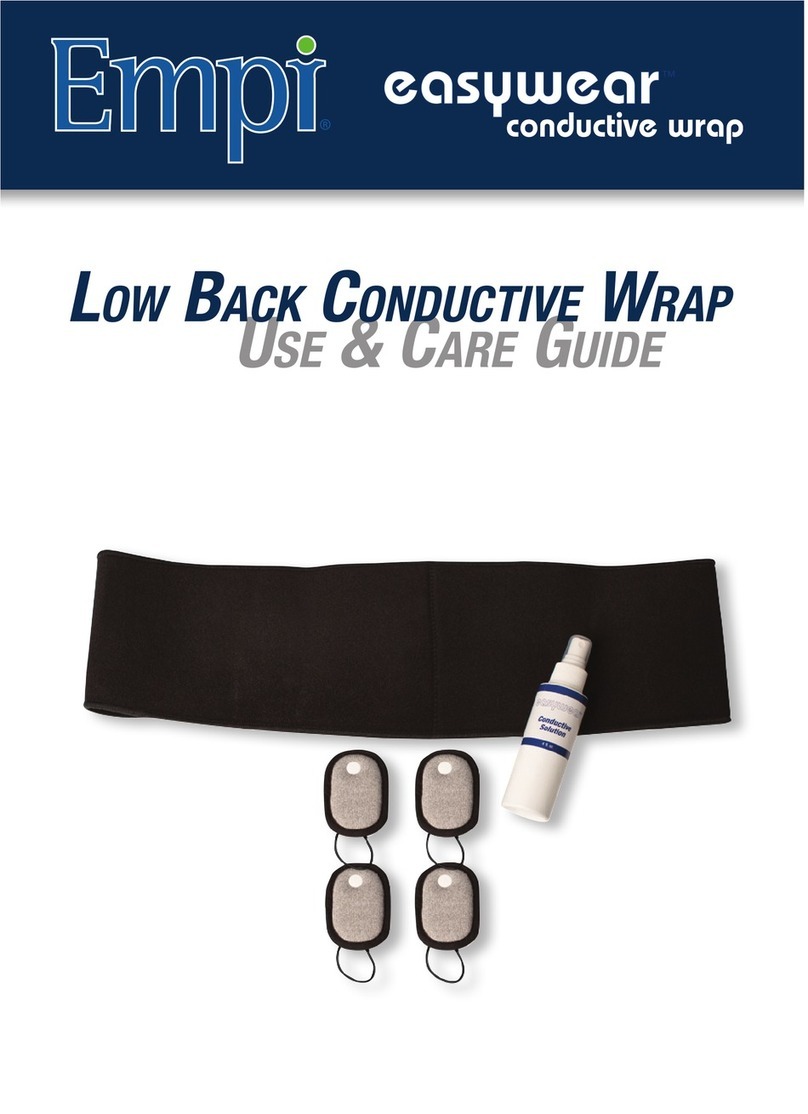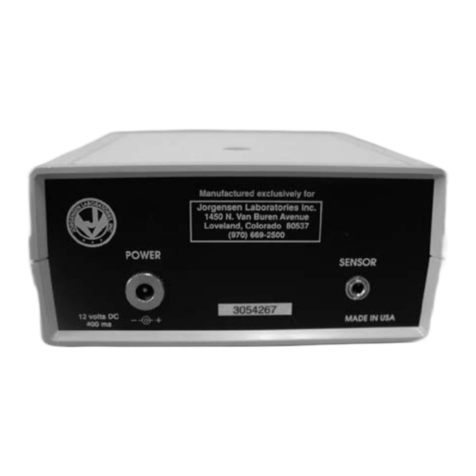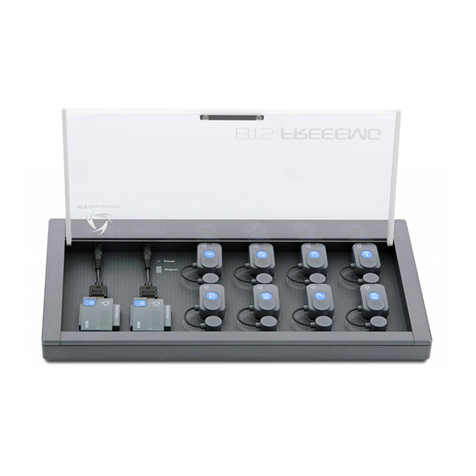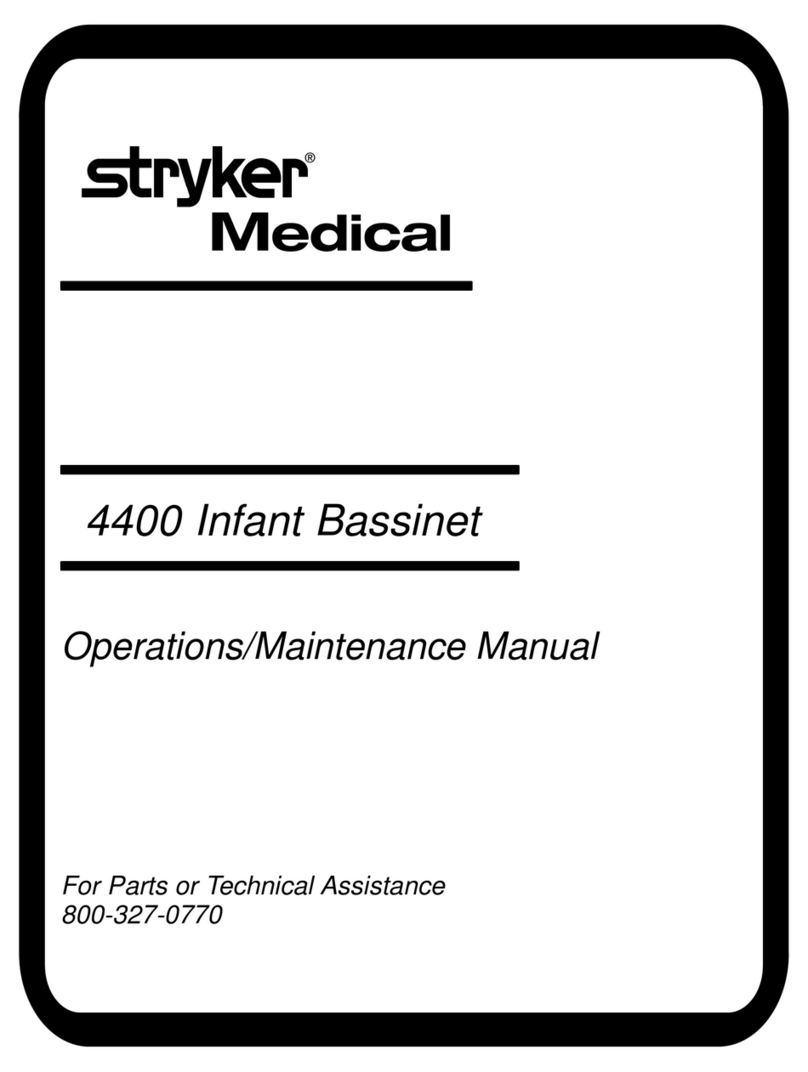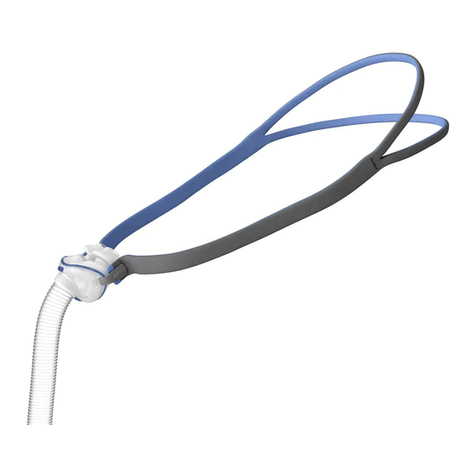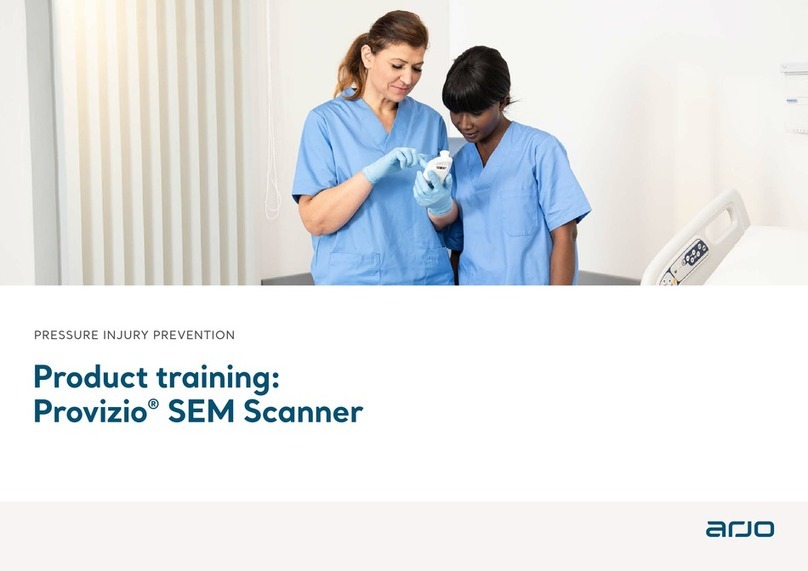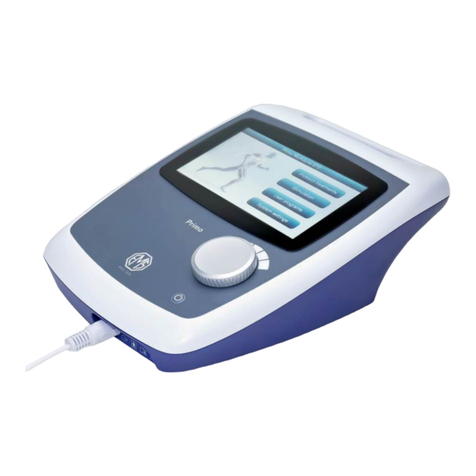Empi Select User manual

User’s Manual
user_manual_NEW_BH_edit_r5.indd 1 3/3/08 2:08:31 PM

Select User’s Manual 3
Table of Contents
Empi
© 2008 Empi All rights reserved.
CAUTION: Federal Law (USA) restricts this device to sale by or on the order of a
physician (or licensed practitioner).
The following symbols may be located on the back of the Select stimulator:
Type BF Applied Part
Attention, consult accompanying documents
Lead wires comply with the Performance Standard for
electrode lead wires (21 CFR part 898)
Electronic Testing Lab, indicates product meets US and Canadian product safety
standards. This device complies with UL 60601-1 and CSA C22.2 No. 601-1-M90.
9900900
Council Directive 2002/96/EC concerning Waste Electrical and Electronic Equipment
(WEEE). Indicates a requirement not to dispose of WEEE as municipal waste. Contact
your local distributor for information regarding disposal of the unit and accessories.
Introduction
.......................................................... 6
How Select Works....................................................................6
Main Operating Components ...........................................................7
Prescribing Information
................................................ 8
Indications
.............................................................. 8
Contraindications
......................................................... 8
Warnings
............................................................. 9
Precautions .................................................................................
11
Dangers ....................................................................................
13
Adverse Effects
......................................................... 13
Quick Reference
...................................................... 14
Starting a Therapy Session .............................................................14
Changing a Therapy Session ...........................................................14
Ending a Therapy Session.............................................................. 15
System Components
.................................................. 16
Device .............................................................................16
Device Physical Features ..............................................................17
LCD Screen....................................................................... 17
Operating Buttons ..................................................................18
Intensity Lockout Feature ............................................................. 18
Output Jacks ...................................................................... 18
On/Off Indicator Lights ...............................................................19
Battery Compartment ................................................................ 19
Belt Clip .........................................................................19
Carrying Case .....................................................................19
Documentation ....................................................................19
Lead Wires .......................................................................20
Electrodes ........................................................................20
Operation
............................................................ 21
Overview ...........................................................................21
Installing the Batteries.................................................................22
Connecting the Lead Wires to the Electrodes .............................................. 23
Connecting the Lead Wires to the Device ................................................. 24
Preparing the Skin for a Therapy Session..................................................24
Applying the Electrodes to the Skin ......................................................25
Turning on the Device .................................................................26
Choosing the Treatment Settings ........................................................26
Intensity Lockout Feature ..............................................................26
user_manual_NEW_BH_edit_r5.indd 2-3 3/3/08 2:08:31 PM

Select User’s Manual 3
Table of Contents
Empi
© 2008 Empi All rights reserved.
CAUTION: Federal Law (USA) restricts this device to sale by or on the order of a
physician (or licensed practitioner).
The following symbols may be located on the back of the Select stimulator:
Type BF Applied Part
Attention, consult accompanying documents
Lead wires comply with the Performance Standard for
electrode lead wires (21 CFR part 898)
Electronic Testing Lab, indicates product meets US and Canadian product safety
standards. This device complies with UL 60601-1 and CSA C22.2 No. 601-1-M90.
9900900
Council Directive 2002/96/EC concerning Waste Electrical and Electronic Equipment
(WEEE). Indicates a requirement not to dispose of WEEE as municipal waste. Contact
your local distributor for information regarding disposal of the unit and accessories.
Introduction
.......................................................... 6
How Select Works....................................................................6
Main Operating Components ........................................................... 7
Prescribing Information
................................................ 8
Indications
.............................................................. 8
Contraindications
......................................................... 8
Warnings
............................................................. 9
Precautions .................................................................................
11
Dangers ....................................................................................
13
Adverse Effects
......................................................... 13
Quick Reference
...................................................... 14
Starting a Therapy Session .............................................................14
Changing a Therapy Session ...........................................................14
Ending a Therapy Session.............................................................. 15
System Components
.................................................. 16
Device .............................................................................16
Device Physical Features ..............................................................17
LCD Screen....................................................................... 17
Operating Buttons ..................................................................18
Intensity Lockout Feature ............................................................. 18
Output Jacks ...................................................................... 18
On/Off Indicator Lights ...............................................................19
Battery Compartment ................................................................ 19
Belt Clip .........................................................................19
Carrying Case .....................................................................19
Documentation ....................................................................19
Lead Wires .......................................................................20
Electrodes ........................................................................20
Operation
............................................................ 21
Overview ...........................................................................21
Installing the Batteries.................................................................22
Connecting the Lead Wires to the Electrodes .............................................. 23
Connecting the Lead Wires to the Device ................................................. 24
Preparing the Skin for a Therapy Session..................................................24
Applying the Electrodes to the Skin ......................................................25
Turning on the Device .................................................................26
Choosing the Treatment Settings ........................................................26
Intensity Lockout Feature ..............................................................26
user_manual_NEW_BH_edit_r5.indd 2-3 3/3/08 2:08:31 PM

Select User’s Manual
4
Select User’s Manual 5
Table of Contents
Quick Select Feature..................................................................26
Program Option Controls ..............................................................27
Beginning Treatment ..................................................................30
Recording Treatment..................................................................30
Ending Treatment ....................................................................30
Using the Timer ......................................................................30
Data Retrieval .......................................................................31
Changing the Batteries ................................................................32
Charging the Batteries ................................................................ 33
Maintenance ........................................................................33
Cleaning ...........................................................................34
Storage ............................................................................34
Disposal............................................................................34
Specifications
........................................................ 35
Physical Characteristics ...............................................................35
Standard Measurement Conditions.......................................................35
Waveform ........................................................................35
Standard Measurement...............................................................35
Pulse Duration .....................................................................35
Maximum Current ....................................................................35
Absolute Average Value...............................................................35
Root Mean Square .................................................................. 35
Electrode Surface Area ...............................................................35
Physical Dimensions .................................................................. 35
Environmental Conditions .............................................................. 35
Program Options and Default Parameters .................................................36
Program Options and Adjustable Parameters ..............................................37
To Select Parameters for Programs ...................................................... 38
Data Retrieval Codes..................................................................38
Battery Information ...................................................................38
Waveforms .........................................................................38
Electromagnetic Compatibility (EMC) Tables ...............................................40
Troubleshooting
....................................................... 44
Replacement Parts
.................................................... 47
Warranty
............................................................ 48
user_manual_NEW_BH_edit_r5.indd 4-5 3/3/08 2:08:32 PM

Select User’s Manual
4
Select User’s Manual 5
Table of Contents
Quick Select Feature..................................................................26
Program Option Controls ..............................................................27
Beginning Treatment ..................................................................30
Recording Treatment..................................................................30
Ending Treatment ....................................................................30
Using the Timer ......................................................................30
Data Retrieval .......................................................................31
Changing the Batteries ................................................................32
Charging the Batteries ................................................................ 33
Maintenance ........................................................................33
Cleaning ...........................................................................34
Storage ............................................................................34
Disposal............................................................................34
Specifications
........................................................ 35
Physical Characteristics ...............................................................35
Standard Measurement Conditions.......................................................35
Waveform ........................................................................35
Standard Measurement...............................................................35
Pulse Duration .....................................................................35
Maximum Current ....................................................................35
Absolute Average Value...............................................................35
Root Mean Square .................................................................. 35
Electrode Surface Area ...............................................................35
Physical Dimensions .................................................................. 35
Environmental Conditions .............................................................. 35
Program Options and Default Parameters ................................................. 36
Program Options and Adjustable Parameters ..............................................37
To Select Parameters for Programs ...................................................... 38
Data Retrieval Codes..................................................................38
Battery Information ...................................................................38
Waveforms .........................................................................38
Electromagnetic Compatibility (EMC) Tables ...............................................40
Troubleshooting
....................................................... 44
Replacement Parts
.................................................... 47
Warranty
............................................................ 48
user_manual_NEW_BH_edit_r5.indd 4-5 3/3/08 2:08:32 PM

Select User’s Manual
6
Select User’s Manual 7
IntroductionIntroduction
Congratulations! Your physician has prescribed Empi’s Select Pain Control system to help
you with pain management. Empi is dedicated to helping you regain your active lifestyle
– from our field sales representatives training you on how to use the system, to our patient
coordinators following up with you. We make your success our goal.
How Select Works
What is Pain?
Pain is an unpleasant sensation that can serve a useful purpose by alerting us to a possible
or actual injury or disease. When the body is functioning normally, pain serves as a warning
system that something is not right. Without pain a person would not know when to get
away from danger or seek medical help. But pain becomes a problem when it continues
after treatment has started or long after an injury is healed.
There are two types of pain: acute and chronic. Acute pain is limited in duration. Typical
examples are sprains, incisional pain or muscle strain. This type of pain is typically
associated with workplace or recreational injuries. Chronic pain, however, is a long-lasting,
persistent pain that ceases to serve as a warning system and becomes a problem.
The Select was developed to help relieve some types of both chronic and acute pain.
What is TENS?
TENS stands for Transcutaneous Electrical Nerve Stimulation. Pain, whether chronic
(long-term) or acute (short-term), can be relieved through a variety of methods, including
drugs, topical ointments, surgery, and electrical stimulation. TENS devices deliver electrical
pulses through the skin to the cutaneous (surface) and afferent (deep) nerves to control
pain. Unlike drugs and topical ointments, TENS does not have any systemic side effects.
How Does TENS Control Pain?
The Select provides pain relief in two ways. The first is the gate control method. When the
body is injured, both pain and non-pain impulses are sent to the brain from the nervous
system. These pulses travel through the cutaneous nerves to the deeper, afferent nerves,
and then to the spinal cord and brain. Along the path are many areas referred to as “gates,”
which determine which impulses are allowed to continue on to the brain. The gates prevent
the brain from receiving too much information too quickly. Since the same nerve cannot
carry a pain and a non-pain impulse at the same time, the stronger, non-pain impulse from
the Select device “controls the gate.”
The second method of pain control is the endorphin release method. The Select device
can be set to trigger the body’s natural pain killers, called endoprhins. These chemicals
interact with recpetors, blocking the perception of pain. This is similar to the way the
pharmaceutical drug morphine works, but without the side effect associated with morphine.
No matter which pain control method is employed, the Select has been proven useful in
pain management. By reading this manual and carefully following the treatment instructions
provided by your clinician, you can attain maximum benefit from your Select device.
Consult a health care professional (clinician) if you have specific questions or
problems regarding the use of the device. They are most familiar with your situation
and are the best source of additional guidance. This system should be used only
under proper medical supervision and only as described by this manual.
Before using your Select Pain Control system, please read all of the indications,
contraindications, warnings, and precautions in the Prescribing Information section
(on page 8).
Main Operating Components
user_manual_NEW_BH_edit_r5.indd 6-7 3/3/08 2:08:32 PM

Select User’s Manual
6
Select User’s Manual 7
IntroductionIntroduction
Congratulations! Your physician has prescribed Empi’s Select Pain Control system to help
you with pain management. Empi is dedicated to helping you regain your active lifestyle
– from our field sales representatives training you on how to use the system, to our patient
coordinators following up with you. We make your success our goal.
How Select Works
What is Pain?
Pain is an unpleasant sensation that can serve a useful purpose by alerting us to a possible
or actual injury or disease. When the body is functioning normally, pain serves as a warning
system that something is not right. Without pain a person would not know when to get
away from danger or seek medical help. But pain becomes a problem when it continues
after treatment has started or long after an injury is healed.
There are two types of pain: acute and chronic. Acute pain is limited in duration. Typical
examples are sprains, incisional pain or muscle strain. This type of pain is typically
associated with workplace or recreational injuries. Chronic pain, however, is a long-lasting,
persistent pain that ceases to serve as a warning system and becomes a problem.
The Select was developed to help relieve some types of both chronic and acute pain.
What is TENS?
TENS stands for Transcutaneous Electrical Nerve Stimulation. Pain, whether chronic
(long-term) or acute (short-term), can be relieved through a variety of methods, including
drugs, topical ointments, surgery, and electrical stimulation. TENS devices deliver electrical
pulses through the skin to the cutaneous (surface) and afferent (deep) nerves to control
pain. Unlike drugs and topical ointments, TENS does not have any systemic side effects.
How Does TENS Control Pain?
The Select provides pain relief in two ways. The first is the gate control method. When the
body is injured, both pain and non-pain impulses are sent to the brain from the nervous
system. These pulses travel through the cutaneous nerves to the deeper, afferent nerves,
and then to the spinal cord and brain. Along the path are many areas referred to as “gates,”
which determine which impulses are allowed to continue on to the brain. The gates prevent
the brain from receiving too much information too quickly. Since the same nerve cannot
carry a pain and a non-pain impulse at the same time, the stronger, non-pain impulse from
the Select device “controls the gate.”
The second method of pain control is the endorphin release method. The Select device
can be set to trigger the body’s natural pain killers, called endoprhins. These chemicals
interact with recpetors, blocking the perception of pain. This is similar to the way the
pharmaceutical drug morphine works, but without the side effect associated with morphine.
No matter which pain control method is employed, the Select has been proven useful in
pain management. By reading this manual and carefully following the treatment instructions
provided by your clinician, you can attain maximum benefit from your Select device.
Consult a health care professional (clinician) if you have specific questions or
problems regarding the use of the device. They are most familiar with your situation
and are the best source of additional guidance. This system should be used only
under proper medical supervision and only as described by this manual.
Before using your Select Pain Control system, please read all of the indications,
contraindications, warnings, and precautions in the Prescribing Information section
(on page 8).
Main Operating Components
user_manual_NEW_BH_edit_r5.indd 6-7 3/3/08 2:08:32 PM

Select User’s Manual
8
Select User’s Manual 9
Prescribing InformationPrescribing Information
In general, stimulation should be used under medical supervision in the management of
specific conditions.
Read, understand, and practice the precautionary and operating instructions found in this
manual. Know the limitations and hazards associated with the Select Pain Control system.
Observe any and all precautionary and operational decals placed on the unit.
Indications
TENS devices are indicated for:
•Symptomatic relief and management of chronic, intractable pain
•Adjunctive treatment for post-surgical and post-trauma acute pain
•For the relief of pain associated with arthritis
Contraindications
TENS treatments should not be used if you have any of the following:
Cardiac pacemakers
– Do not use this device if the patient has a demand-type
cardiac pacemaker or any implanted defibrillator.
Transcerebral stimulation
– Do not apply electrical stimulation transcerebrally
(through the head).
Carotid sinus
– Do not use electrical stimulation over the carotid sinus nerves (throat).
Unknown etiology
– Do not use this device when pain syndromes are undiagnosed.
Use only after origin of pain has been diagnosed.
Warnings
Supervised use
– This device should only be operated under the prescription and
supervision of a physician (or licensed practitioner) that is familiar with the precautionary
measures and operational functions associated with the unit being used.
Long-term effects
– The long-term effects of chronic use of electrical stimulation are
unknown. Electrical stimulation devices do not have any curative value.
Symptomatic treatment
– This device is a symptomatic treatment and, as such,
suppresses the sensation of pain, which would otherwise serve as a protective mechanism.
Central origin pain
– Electrical stimulation is not effective for central origin pain such
as headache.
Pregnancy
– The safety of using electrical stimulation during pregnancy or birth has not
been established.
Throat stimulation
– Severe spasm of the laryngeal and pharyngeal muscles may occur
when the electrodes are placed across the throat or mouth. This may be strong enough to
close off the airway or cause breathing difficulty.
Transthoracic stimulation
–Do not apply electrical stimulation transthoracically
(through the chest area) in that the introduction of electrical current into the heart may
cause cardiac arrhythmias.
Skin and vascular problems
– Do not use this device over infected areas, skin eruptions,
or areas of decreased sensation.
Heart disease
– Precaution should be taken prior to using electrical stimulation on
patients suspected of having heart disease.
High frequency surgical devices
– Simultaneous connection of a patient to a high
frequency surgical device may result in burns at the site of the electrodes and possible
damage to the device.
Damage from liquids
– Do not immerse the device in water or other liquids. Water or
liquids could cause malfunction of internal components of the system, causing a risk of
injury to the patient.
Electrical shock
– To prevent electrical shock, disconnect the unit from the power source
before attempting any maintenance procedures.
Uncomfortable stimulation
– If the stimulation levels are uncomfortable or become
uncomfortable, reduce the intensity to a comfortable level. Contact your clinician if this
does not resolve the problem or if the problem persists.
user_manual_NEW_BH_edit_r5.indd 8-9 3/3/08 2:08:33 PM

Select User’s Manual
8
Select User’s Manual 9
Prescribing InformationPrescribing Information
In general, stimulation should be used under medical supervision in the management of
specific conditions.
Read, understand, and practice the precautionary and operating instructions found in this
manual. Know the limitations and hazards associated with the Select Pain Control system.
Observe any and all precautionary and operational decals placed on the unit.
Indications
TENS devices are indicated for:
•Symptomatic relief and management of chronic, intractable pain
•Adjunctive treatment for post-surgical and post-trauma acute pain
•For the relief of pain associated with arthritis
Contraindications
TENS treatments should not be used if you have any of the following:
Cardiac pacemakers
– Do not use this device if the patient has a demand-type
cardiac pacemaker or any implanted defibrillator.
Transcerebral stimulation
– Do not apply electrical stimulation transcerebrally
(through the head).
Carotid sinus
– Do not use electrical stimulation over the carotid sinus nerves (throat).
Unknown etiology
– Do not use this device when pain syndromes are undiagnosed.
Use only after origin of pain has been diagnosed.
Warnings
Supervised use
– This device should only be operated under the prescription and
supervision of a physician (or licensed practitioner) that is familiar with the precautionary
measures and operational functions associated with the unit being used.
Long-term effects
– The long-term effects of chronic use of electrical stimulation are
unknown. Electrical stimulation devices do not have any curative value.
Symptomatic treatment
– This device is a symptomatic treatment and, as such,
suppresses the sensation of pain, which would otherwise serve as a protective mechanism.
Central origin pain
– Electrical stimulation is not effective for central origin pain such
as headache.
Pregnancy
– The safety of using electrical stimulation during pregnancy or birth has not
been established.
Throat stimulation
– Severe spasm of the laryngeal and pharyngeal muscles may occur
when the electrodes are placed across the throat or mouth. This may be strong enough to
close off the airway or cause breathing difficulty.
Transthoracic stimulation
–Do not apply electrical stimulation transthoracically
(through the chest area) in that the introduction of electrical current into the heart may
cause cardiac arrhythmias.
Skin and vascular problems
– Do not use this device over infected areas, skin eruptions,
or areas of decreased sensation.
Heart disease
– Precaution should be taken prior to using electrical stimulation on
patients suspected of having heart disease.
High frequency surgical devices
– Simultaneous connection of a patient to a high
frequency surgical device may result in burns at the site of the electrodes and possible
damage to the device.
Damage from liquids
– Do not immerse the device in water or other liquids. Water or
liquids could cause malfunction of internal components of the system, causing a risk of
injury to the patient.
Electrical shock
– To prevent electrical shock, disconnect the unit from the power source
before attempting any maintenance procedures.
Uncomfortable stimulation
– If the stimulation levels are uncomfortable or become
uncomfortable, reduce the intensity to a comfortable level. Contact your clinician if this
does not resolve the problem or if the problem persists.
user_manual_NEW_BH_edit_r5.indd 8-9 3/3/08 2:08:33 PM

Select User’s Manual
10
Select User’s Manual 11
Prescribing InformationPrescribing Information
Skin reactions
– On rare occasions, therapy can result in transient skin reactions such
as rash, inflammation, irritation, or burns. These skin reactions may be the result of
individual sensitivity to the condition of the skin at the onset of treatment, reaction to the
materials in the electrodes, or a poor connection between the electrode and your skin.
If a visible skin reaction does occur, discontinue the treatment and consult the prescribing
physician or licensed practitioner.
Lead connection
– Do not connect the lead wires to an AC power source or other
equipment not specified as safe for the lead wires. Doing so could result in severe shock
or burns whether or not the lead wires are attached to the stimulator.
Electromagnetic compatibility
– Care must be taken when operating this device
adjacent to or stacked with other equipment. Potential electromagnetic or other
interference could occur to this or other equipment. Try to minimize this interference by
not using other equipment in conjunction with it. (i.e. cell phones, etc.)
Accessories
– Use only accessories that are specially designed for this device. Do not use
accessories manufactured by other companies on this device. Empi is not responsible for
any consequence resulting from using products manufactured by other companies. The use
of other accessories or cables may result in increased emissions or decreased immunity of
this device.
Defibrillation signals
– Remove the TENS electrodes before defibrillation signals are
applied. Defibrillation of a person wearing a TENS device can damage the device whether
it is turned on or off. Under some circumstances there can be risk of burns under the
electrode sites during the defibrillation.
Safety
– The safety and efficacy of the Select system depends on the proper use and
handling of the device and accessories. If used improperly, the Select system has a
potentially hazardous electrical output. It must be used only as prescribed. Electrode
or lead wire burns may result from misuse. Electrodes and lead wires should be securely
fastened to prevent inadvertent disconnection. The length of lead wires could result in
injury. Electrodes and lead wires will eventually wear out. Check accessories regularly
for signs of wear, and replace if needed.
Proper electrode size
– Output current density is related to electrode size. Improper
application may result in patient injury. If any question arises as to the proper electrode
size, consult a licensed practitioner prior to therapy session.
Epilepsy
– Use caution for patients with suspected or diagnosed epilepsy when using
this device.
Hemorrhages
– Use caution when there is a tendency to hemorrhage, such as following
acute trauma or fracture.
Post-surgical use
– Use caution following recent surgical procedures when muscle
contraction may disrupt the healing process.
Uterus
– Do not use electrical stimulation over a menstruating or pregnant uterus.
Sensory loss
– Do not use electrical stimulation where sensory nerve damage is present,
causing a loss of normal skin sensation.
Unequal electrode size
– Using different size electrodes together can cause skin irritation
or increased stimulation intensity under the smaller electrode. Some programs may require
the use of different sized electrodes for treatment.
Prescription
– Use electrical stimulation only in the prescribed manner and for the
prescribed diagnosis. If there are any changes in an existing condition, or if a new condition
develops, the patient should consult a physician.
Effectiveness
– Effectiveness is highly dependent upon patient selection by a clinician
qualified in the management of pain or rehabilitation.
Keep out of reach of children
– Keep this device out of the reach of children. If the
patient is a child, make sure he/she is properly supervised during electrical stimulation.
Leads and electrodes
– Use the device with only the leads and electrodes provided for
use by the manufacturer. The safety of other products has not been established, and their
use could result in injury to the patient. Use only the electrode placements and stimulation
settings prescribed by your practitioner.
NOTE:
An electrode active area of no less than 1.227 in2(7.917 cm2) is recommended for
the Select system.
NOTE:
The Select system requires the use of Empi lead wires with the custom safety
connection as pictured.
Precautions
user_manual_NEW_BH_edit_r5.indd 10-11 3/3/08 2:08:33 PM

Select User’s Manual
10
Select User’s Manual 11
Prescribing InformationPrescribing Information
Skin reactions
– On rare occasions, therapy can result in transient skin reactions such
as rash, inflammation, irritation, or burns. These skin reactions may be the result of
individual sensitivity to the condition of the skin at the onset of treatment, reaction to the
materials in the electrodes, or a poor connection between the electrode and your skin.
If a visible skin reaction does occur, discontinue the treatment and consult the prescribing
physician or licensed practitioner.
Lead connection
– Do not connect the lead wires to an AC power source or other
equipment not specified as safe for the lead wires. Doing so could result in severe shock
or burns whether or not the lead wires are attached to the stimulator.
Electromagnetic compatibility
– Care must be taken when operating this device
adjacent to or stacked with other equipment. Potential electromagnetic or other
interference could occur to this or other equipment. Try to minimize this interference by
not using other equipment in conjunction with it. (i.e. cell phones, etc.)
Accessories
– Use only accessories that are specially designed for this device. Do not use
accessories manufactured by other companies on this device. Empi is not responsible for
any consequence resulting from using products manufactured by other companies. The use
of other accessories or cables may result in increased emissions or decreased immunity of
this device.
Defibrillation signals
– Remove the TENS electrodes before defibrillation signals are
applied. Defibrillation of a person wearing a TENS device can damage the device whether
it is turned on or off. Under some circumstances there can be risk of burns under the
electrode sites during the defibrillation.
Safety
– The safety and efficacy of the Select system depends on the proper use and
handling of the device and accessories. If used improperly, the Select system has a
potentially hazardous electrical output. It must be used only as prescribed. Electrode
or lead wire burns may result from misuse. Electrodes and lead wires should be securely
fastened to prevent inadvertent disconnection. The length of lead wires could result in
injury. Electrodes and lead wires will eventually wear out. Check accessories regularly
for signs of wear, and replace if needed.
Proper electrode size
– Output current density is related to electrode size. Improper
application may result in patient injury. If any question arises as to the proper electrode
size, consult a licensed practitioner prior to therapy session.
Epilepsy
– Use caution for patients with suspected or diagnosed epilepsy when using
this device.
Hemorrhages
– Use caution when there is a tendency to hemorrhage, such as following
acute trauma or fracture.
Post-surgical use
– Use caution following recent surgical procedures when muscle
contraction may disrupt the healing process.
Uterus
– Do not use electrical stimulation over a menstruating or pregnant uterus.
Sensory loss
– Do not use electrical stimulation where sensory nerve damage is present,
causing a loss of normal skin sensation.
Unequal electrode size
– Using different size electrodes together can cause skin irritation
or increased stimulation intensity under the smaller electrode. Some programs may require
the use of different sized electrodes for treatment.
Prescription
– Use electrical stimulation only in the prescribed manner and for the
prescribed diagnosis. If there are any changes in an existing condition, or if a new condition
develops, the patient should consult a physician.
Effectiveness
– Effectiveness is highly dependent upon patient selection by a clinician
qualified in the management of pain or rehabilitation.
Keep out of reach of children
– Keep this device out of the reach of children. If the
patient is a child, make sure he/she is properly supervised during electrical stimulation.
Leads and electrodes
– Use the device with only the leads and electrodes provided for
use by the manufacturer. The safety of other products has not been established, and their
use could result in injury to the patient. Use only the electrode placements and stimulation
settings prescribed by your practitioner.
NOTE:
An electrode active area of no less than 1.227 in2(7.917 cm2) is recommended for
the Select system.
NOTE:
The Select system requires the use of Empi lead wires with the custom safety
connection as pictured.
Precautions
user_manual_NEW_BH_edit_r5.indd 10-11 3/3/08 2:08:33 PM

Select User’s Manual
12
Select User’s Manual 13
Prescribing InformationPrescribing Information
Electronic equipment
– Electronic monitoring equipment (such as ECG and ECG alarms)
may not operate properly when electrical stimulation is in use.
Microwave or radio frequency sources
– Operation in close proximity, such as 3 feet
(1 meter), to shortwave or microwave therapy equipment may produce instability in the
device output and may shut the device off.
Machineryoperation
– Patient should never operate potentially dangerous machinery
such as power saws, automobiles, etc. during electrical stimulation.
Flammable
– Do not use the device in an environment where flammable or explosive
fumes may exist.
Externaluse
– This device is for external use only.
Electromagnetic energy
– Do not operate this unit in an environment where other
devices are being used that intentionally radiate electromagnetic energy in an unshielded
manner. Portable and mobile RF communications equipment can affect medical
electrical equipment.
Sharp objects
– Do not use sharp objects such as a pencil point or ballpoint pen to
operate the buttons on the control panel.
Cables andconnectors
– Inspect cables and connectors before each use.
Treatment outcome
– Treatment outcome will be influenced by the patient’s
psychological state and use of drugs.
Negative reaction to stimulation
– Patients who react negatively to the stimulation
sensation after an adequate trial period or who find stimulation intolerable should not
undergo further treatment.
Operation conditions
– This unit should be operated in temperatures between
50° F and 104° F (10° C and 40° C), atmospheric pressures between 50 and 106 kPa,
and relative humidity between 30% and 75%.
Transportation andstorage conditions
– This unit should be transported and stored
in temperatures between -40° F and 158° F (-40° C and 70° C), atmospheric pressures
between 50 and 106 kPa, and relative humidity between 10% - 90%.
Batteries
– Remove the Select system batteries if the unit is to be unused for an extended
period of time, i.e. 2 weeks or more.
Transportation of batteries
– Do not carry batteries in a pocket, purse or any other
place where the terminals could become short-circuited, e.g. by way of a coin or paper clip.
Intense heat could be generated and injury may result.
Using device while sleeping
– Do not use while sleeping because the lead wires or the
electrodes may become disconnected.
Heat and coldproducts
– The use of heat or cold producing devices, such as electric
heating blankets, heating pads or ice packs, may impair the performance of the electrode
or alter the patient’s circulation/sensitivity and increase the risk of injury to the patient.
Battery charger
– Only the Empi battery charger should be used with Empi rechargeable
batteries. Do not attempt to recharge any battery other than the rechargeable battery
supplied by Empi for this device. Attempts to charge alkaline or other non-rechargeable
batteries could cause the battery to overheat, burst, or be permanently damaged.
Radio frequency generation
– This equipment generates, uses, and can radiate
radio frequency energy and if not installed and used in accordance with the instructions,
may cause harmful interference to other devices in the vicinity. However, there is no
guarantee that interference will not occur in a particular installation.Harmful interference
to other devices can be determined by turning the unit on and off. Try to correct the
interference using one or more of the following: reorient orrelocate the receiving device,
increase the separation between the equipment and consult the Empi Service Department
for help.
Adverse Effects
Skin irritation, inflammation, and electrode burns beneath the electrodes are potential
adverse reactions.
Dangers
Dangerous voltage
– Stimulus delivered by the TENS waveforms of this device,
in certain configurations, will deliver a charge of up to 20 microcoulombs (µC) or
greater per pulse and may be sufficient to cause electrocution. Electrical current
of this magnitude must not flow through the thorax because it may cause a
cardiac arrhythmia.
Biohazardous materials
– Handle, clean, and dispose of components and
accessories that have come in contact with bodily fluids according to national,
local, and facility rules, regulations, and procedures.
user_manual_NEW_BH_edit_r5.indd 12-13 3/3/08 2:08:34 PM

Select User’s Manual
12
Select User’s Manual 13
Prescribing InformationPrescribing Information
Electronic equipment
– Electronic monitoring equipment (such as ECG and ECG alarms)
may not operate properly when electrical stimulation is in use.
Microwave or radio frequency sources
– Operation in close proximity, such as 3 feet
(1 meter), to shortwave or microwave therapy equipment may produce instability in the
device output and may shut the device off.
Machineryoperation
– Patient should never operate potentially dangerous machinery
such as power saws, automobiles, etc. during electrical stimulation.
Flammable
– Do not use the device in an environment where flammable or explosive
fumes may exist.
Externaluse
– This device is for external use only.
Electromagnetic energy
– Do not operate this unit in an environment where other
devices are being used that intentionally radiate electromagnetic energy in an unshielded
manner. Portable and mobile RF communications equipment can affect medical
electrical equipment.
Sharp objects
– Do not use sharp objects such as a pencil point or ballpoint pen to
operate the buttons on the control panel.
Cables andconnectors
– Inspect cables and connectors before each use.
Treatment outcome
– Treatment outcome will be influenced by the patient’s
psychological state and use of drugs.
Negative reaction to stimulation
– Patients who react negatively to the stimulation
sensation after an adequate trial period or who find stimulation intolerable should not
undergo further treatment.
Operation conditions
– This unit should be operated in temperatures between
50° F and 104° F (10° C and 40° C), atmospheric pressures between 50 and 106 kPa,
and relative humidity between 30% and 75%.
Transportation andstorage conditions
– This unit should be transported and stored
in temperatures between -40° F and 158° F (-40° C and 70° C), atmospheric pressures
between 50 and 106 kPa, and relative humidity between 10% - 90%.
Batteries
– Remove the Select system batteries if the unit is to be unused for an extended
period of time, i.e. 2 weeks or more.
Transportation of batteries
– Do not carry batteries in a pocket, purse or any other
place where the terminals could become short-circuited, e.g. by way of a coin or paper clip.
Intense heat could be generated and injury may result.
Using device while sleeping
– Do not use while sleeping because the lead wires or the
electrodes may become disconnected.
Heat and coldproducts
– The use of heat or cold producing devices, such as electric
heating blankets, heating pads or ice packs, may impair the performance of the electrode
or alter the patient’s circulation/sensitivity and increase the risk of injury to the patient.
Battery charger
– Only the Empi battery charger should be used with Empi rechargeable
batteries. Do not attempt to recharge any battery other than the rechargeable battery
supplied by Empi for this device. Attempts to charge alkaline or other non-rechargeable
batteries could cause the battery to overheat, burst, or be permanently damaged.
Radio frequency generation
– This equipment generates, uses, and can radiate
radio frequency energy and if not installed and used in accordance with the instructions,
may cause harmful interference to other devices in the vicinity. However, there is no
guarantee that interference will not occur in a particular installation.Harmful interference
to other devices can be determined by turning the unit on and off. Try to correct the
interference using one or more of the following: reorient orrelocate the receiving device,
increase the separation between the equipment and consult the Empi Service Department
for help.
Adverse Effects
Skin irritation, inflammation, and electrode burns beneath the electrodes are potential
adverse reactions.
Dangers
Dangerous voltage
– Stimulus delivered by the TENS waveforms of this device,
in certain configurations, will deliver a charge of up to 20 microcoulombs (µC) or
greater per pulse and may be sufficient to cause electrocution. Electrical current
of this magnitude must not flow through the thorax because it may cause a
cardiac arrhythmia.
Biohazardous materials
– Handle, clean, and dispose of components and
accessories that have come in contact with bodily fluids according to national,
local, and facility rules, regulations, and procedures.
user_manual_NEW_BH_edit_r5.indd 12-13 3/3/08 2:08:34 PM

Select User’s Manual
14
Select User’s Manual 15
1. Follow steps 1 through 4 in Starting a Therapy Session, above.
2. Select offers nine (9) program options. Selecting a specific program option
is done by pressing the button or one of the five Quick Select Program
buttons.
3. Use the Ch1 and Ch 2 buttons (fig. ch) to set the intensity for each
channel, as directed by your clinician.
4. On the device, press the button to shut the device off.
Quick ReferenceQuick Reference
When you are very familiar with the operation of the Select system, use the following steps
as a quick reference to operate the device. For more information, refer to the Operation
section in this manual.
Starting a Therapy Session
1. Connect the lead wire(s) to the electrodes and the device.
NOTE:
Make sure the device is turned off before connecting the lead wires to the device.
2. Wash and dry the skin areas where you will be applying the electrodes.
Use skin prep if necessary.
3. Apply the electrodes to your skin.
4. On the device, press the button to display the Program screen. The
software version will flash, then the entire LCD display will be displayed for 1/2
second. The last program used will display.
channel,as directed by your clinician. The program will begin to operate.
6. On the device, press the button to shut the device off.
Changing a Therapy Session
Ending a Therapy Session
1. On the device, press the button to shut the device off.
2. Unclip the belt clip from your clothing.
3. Disconnect the lead wire(s) from the device.
4. Disconnect the lead wire(s) from the electrodes.
5. Remove the electrodes from your skin. Follow the instructions on the electrode
package for storing electrodes. If necessary, use adhesive remover to remove
any remaining adhesive (or gel) from your skin.
6. Use skin cream or lotion to moisturize your skin after removing the electrodes.
7. Remove the batteries from the device prior to storing.
8. Store the components in the carrying case.
CORRECT NOT CORRECT
fig. ch
fig. ch
user_manual_NEW_BH_edit_r5.indd 14-15 3/3/08 2:08:35 PM
5. Use the Ch1 and Ch2 buttons (fig. ch) to set the intensity for each

Select User’s Manual
14
Select User’s Manual 15
1. Follow steps 1 through 4 in Starting a Therapy Session, above.
2. Select offers nine (9) program options. Selecting a specific program option
is done by pressing the button or one of the five Quick Select Program
buttons.
3. Use the Ch1 and Ch 2 buttons (fig. ch) to set the intensity for each
channel, as directed by your clinician.
4. On the device, press the button to shut the device off.
Quick ReferenceQuick Reference
When you are very familiar with the operation of the Select system, use the following steps
as a quick reference to operate the device. For more information, refer to the Operation
section in this manual.
Starting a Therapy Session
1. Connect the lead wire(s) to the electrodes and the device.
NOTE:
Make sure the device is turned off before connecting the lead wires to the device.
2. Wash and dry the skin areas where you will be applying the electrodes.
Use skin prep if necessary.
3. Apply the electrodes to your skin.
4. On the device, press the button to display the Program screen. The
software version will flash, then the entire LCD display will be displayed for 1/2
second. The last program used will display.
channel,as directed by your clinician. The program will begin to operate.
6. On the device, press the button to shut the device off.
Changing a Therapy Session
Ending a Therapy Session
1. On the device, press the button to shut the device off.
2. Unclip the belt clip from your clothing.
3. Disconnect the lead wire(s) from the device.
4. Disconnect the lead wire(s) from the electrodes.
5. Remove the electrodes from your skin. Follow the instructions on the electrode
package for storing electrodes. If necessary, use adhesive remover to remove
any remaining adhesive (or gel) from your skin.
6. Use skin cream or lotion to moisturize your skin after removing the electrodes.
7. Remove the batteries from the device prior to storing.
8. Store the components in the carrying case.
CORRECT NOT CORRECT
fig. ch
fig. ch
user_manual_NEW_BH_edit_r5.indd 14-15 3/3/08 2:08:35 PM
5. Use the Ch1 and Ch2 buttons (fig. ch) to set the intensity for each

Select User’s Manual
16
Select User’s Manual 17
System ComponentsSystem Components
The Select system is a battery-operated electrical stimulator. The device has five Quick
Select programs and four program options that can be customized by a clinician.
Device
Intensity
Controls
(Channel 2)
Intensity
Controls
(Channel 1)
Session Parameter
Control
Program Option
Control
Quick
Select
Buttons
Quick
Select
Buttons
ON/OFF
Button
Channel Output Jacks
ON/OFF Indicator Lights
Device
Side View
Device
Front View
Belt Clip and
Battery
Compartment
Cover
Device
Back View
LCD Screen
This is the area that displays the therapy settings as you program and use the stimulator.
•
Channel icons
– denotes the channel being used – Channel 1 and/or Channel 2.
•
Intensity
– displayed under the Channel icons and ranges from 0.0 to 60.0
in 0.5 increments.
•
Software version
– displays for a few seconds when the Select is turned on.
•
Data
– denotes that the unit is in Data Retrieval Mode or in Quick Select
Button Reset Mode.
•
Rate
– when adjusting the pulses per second, “Rate” will be displayed next to
the value, along with “pps”.
•
Cycle
– when adjusting the cycle time, “Cycle” will be displayed next to the
cycle time value along with “sec”.
•
Span
– when adjusting the span percentage, “Span” will be displayed next to
the span percentage value along with “%”.
•
Custom text
– for each of the Quick Select Program options, when the
default parameters have been changed and saved, the Custom text will
denote that the buttons have been customized.
•
Program options
– four program options (Continuous, Burst, SMP and
Modulation) can be selected with the Mode button.
•
Lock icon
– when treatment intensity is set at greater than zero and no activity
has occurred within 15 seconds, the Lock icon appears to tell the user that the
unit is locked and intensity/program cannot be changed until it is unlocked.
•
Pad contact icons
– two icons – one for each channel; icons will display
and flash, indicating bad contact.
•
Battery icon
– displays the battery life.
•
Quick Select programs
– five pre-set programs for particular body areas
(Knee, Shoulder, Low Back/Hip, Hand/Wrist, and Back).
user_manual_NEW_BH_edit_r5.indd 16-17 3/3/08 2:08:38 PM

Select User’s Manual
16
Select User’s Manual 17
System ComponentsSystem Components
The Select system is a battery-operated electrical stimulator. The device has five Quick
Select programs and four program options that can be customized by a clinician.
Device
Intensity
Controls
(Channel 2)
Intensity
Controls
(Channel 1)
Session Parameter
Control
Program Option
Control
Quick
Select
Buttons
Quick
Select
Buttons
ON/OFF
Button
Channel Output Jacks
ON/OFF Indicator Lights
Device
Side View
Device
Front View
Belt Clip and
Battery
Compartment
Cover
Device
Back View
LCD Screen
This is the area that displays the therapy settings as you program and use the stimulator.
•
Channel icons
– denotes the channel being used – Channel 1 and/or Channel 2.
•
Intensity
– displayed under the Channel icons and ranges from 0.0 to 60.0
in 0.5 increments.
•
Software version
– displays for a few seconds when the Select is turned on.
•
Data
– denotes that the unit is in Data Retrieval Mode or in Quick Select
Button Reset Mode.
•
Rate
– when adjusting the pulses per second, “Rate” will be displayed next to
the value, along with “pps”.
•
Cycle
– when adjusting the cycle time, “Cycle” will be displayed next to the
cycle time value along with “sec”.
•
Span
– when adjusting the span percentage, “Span” will be displayed next to
the span percentage value along with “%”.
•
Custom text
– for each of the Quick Select Program options, when the
default parameters have been changed and saved, the Custom text will
denote that the buttons have been customized.
•
Program options
– four program options (Continuous, Burst, SMP and
Modulation) can be selected with the Mode button.
•
Lock icon
– when treatment intensity is set at greater than zero and no activity
has occurred within 15 seconds, the Lock icon appears to tell the user that the
unit is locked and intensity/program cannot be changed until it is unlocked.
•
Pad contact icons
– two icons – one for each channel; icons will display
and flash, indicating bad contact.
•
Battery icon
– displays the battery life.
•
Quick Select programs
– five pre-set programs for particular body areas
(Knee, Shoulder, Low Back/Hip, Hand/Wrist, and Back).
user_manual_NEW_BH_edit_r5.indd 16-17 3/3/08 2:08:38 PM

Select User’s Manual
18
Select User’s Manual 19
System ComponentsSystem Components
Operating Buttons
These are the buttons you use to program your therapy settings, such as selecting the
treatment program and intensity.
•
On/Off
– used to turn the stimulator on and off.
•
Quick Select programs
– used to select the most commonly used
programs for a particular body area (Knee, Shoulder, Low Back/Hip,
Hand/Wrist, and Back).
•
Mode
– used to select one of four program options (Continuous, Burst,
SMP and Modulation).
•
Set
– used to change the therapy session parameters (Rate, Cycle Time,
and/or Span Percentage) based on which program option is selected. Also
used to access the Timer function.
•
Ch 1
Increase – used to increase the intensity of the electrical current
sent through the channel 1 output jack.
•
Ch 1
Decrease – used to decrease the intensity of the electrical current
sent through the channel 1 output jack.
•
Ch 2
Increase – used to increase the intensity of the electrical current
sent through the channel 2 output jack.
•
Ch 2
Decrease – used to decrease the intensity of the electrical current
sent through the channel 2 output jack.
NOTE:
Pressing the Up or Down intensity controls increases or
decreases the intensity in 0.5 increments. Intensity range is 0.0 to 60.0.
The Up or Down intensity controls can be held down to increase or
decrease the intensity faster.
Output Jacks
The output jacks are where you connect the lead wires to the device. The output jacks are
labeled on the LCD display. Channels 1 and 2 operate independently. There are two (2)
LED indicator lights, one for each channel.
NOTE:
At a high rate, the LED indicator light will flash, looking like it is constantly on. At a
low rate, the LED indicator light will flash slowly.
Intensity Lockout Feature
Once the intensity is raised above zero, with no activity for greater than 15 seconds, the
unit will initiate lockout of the increase intensity buttons. A lock symbol will appear on the
display to signify that this has occurred. This feature prevents any unintended key presses
to increase intensity or change the program option.
On/Off Indicator Lights
The On/Off Indicator Lights indicate that the device is operational. The brightness of
flash changes with the output intensity. As the intensity of the stimulation increases,
the brightness of the light also increases. (Above 40 pps, the light will appear to be
on continuously.)
Carrying Case
A carrying case is included to help protect the Select system and keep it clean.
Store your device and its components in the case when they are not in use.
Battery Compartment
battery compartment is located on
the back of the device. Refer to pages 22-23
for battery installation.
Documentation
Read and understand this user’s manual carefully before operating the Select device.
The user manual is provided in English and Spanish. If you have questions or cannot
read these languages, contact your clinician.
Belt Clip
The belt clip is flexible so you can clip the device to your clothing, allowing you to
receive your treatment while going about your daily activities.
Battery
Compartment
* To unlock, press the Ch 1 or Ch 2 decrease button.
user_manual_NEW_BH_edit_r5.indd 18-19 3/3/08 2:08:38 PM
alkaline batteries. TheThe device is supplied with “AA”

Select User’s Manual
18
Select User’s Manual 19
System ComponentsSystem Components
Operating Buttons
These are the buttons you use to program your therapy settings, such as selecting the
treatment program and intensity.
•
On/Off
– used to turn the stimulator on and off.
•
Quick Select programs
– used to select the most commonly used
programs for a particular body area (Knee, Shoulder, Low Back/Hip,
Hand/Wrist, and Back).
•
Mode
– used to select one of four program options (Continuous, Burst,
SMP and Modulation).
•
Set
– used to change the therapy session parameters (Rate, Cycle Time,
and/or Span Percentage) based on which program option is selected. Also
used to access the Timer function.
•
Ch 1
Increase – used to increase the intensity of the electrical current
sent through the channel 1 output jack.
•
Ch 1
Decrease – used to decrease the intensity of the electrical current
sent through the channel 1 output jack.
•
Ch 2
Increase – used to increase the intensity of the electrical current
sent through the channel 2 output jack.
•
Ch 2
Decrease – used to decrease the intensity of the electrical current
sent through the channel 2 output jack.
NOTE:
Pressing the Up or Down intensity controls increases or
decreases the intensity in 0.5 increments. Intensity range is 0.0 to 60.0.
The Up or Down intensity controls can be held down to increase or
decrease the intensity faster.
Output Jacks
The output jacks are where you connect the lead wires to the device. The output jacks are
labeled on the LCD display. Channels 1 and 2 operate independently. There are two (2)
LED indicator lights, one for each channel.
NOTE:
At a high rate, the LED indicator light will flash, looking like it is constantly on. At a
low rate, the LED indicator light will flash slowly.
Intensity Lockout Feature
Once the intensity is raised above zero, with no activity for greater than 15 seconds, the
unit will initiate lockout of the increase intensity buttons. A lock symbol will appear on the
display to signify that this has occurred. This feature prevents any unintended key presses
to increase intensity or change the program option.
On/Off Indicator Lights
The On/Off Indicator Lights indicate that the device is operational. The brightness of
flash changes with the output intensity. As the intensity of the stimulation increases,
the brightness of the light also increases. (Above 40 pps, the light will appear to be
on continuously.)
Carrying Case
A carrying case is included to help protect the Select system and keep it clean.
Store your device and its components in the case when they are not in use.
Battery Compartment
battery compartment is located on
the back of the device. Refer to pages 22-23
for battery installation.
Documentation
Read and understand this user’s manual carefully before operating the Select device.
The user manual is provided in English and Spanish. If you have questions or cannot
read these languages, contact your clinician.
Belt Clip
The belt clip is flexible so you can clip the device to your clothing, allowing you to
receive your treatment while going about your daily activities.
Battery
Compartment
* To unlock, press the Ch 1 or Ch 2 decrease button.
user_manual_NEW_BH_edit_r5.indd 18-19 3/3/08 2:08:38 PM
alkaline batteries. TheThe device is supplied with “AA”

Select User’s Manual
20
Select User’s Manual 21
System Components Operation
Lead Wires
Lead wires connect the device to the electrodes. They carry the electrical pulses from the
device to the electrodes on your skin. You must have an electrode on both the pins for the
device to work properly.
Electrodes
There are several types and sizes of electrodes, and each type has different characteristics.
The Select usually includes two (2) packs of four (4) 2-inch round or 2-inch square,
reusable, self-adhering electrodes, as shown below. Each electrode has a connector for
inserting a lead wire pin and an electrical-conductive adhesive pad that attaches to your
skin. These electrodes are flexible and conform to the skin very well. They can be reused
10 to 15 times, depending on skin type and electrode care.
Inspect your electrodes before every use. Replace electrodes as needed. If you need
additional electrodes, contact Customer Service at 800-328-2536.
To use these electrodes:
1. Attach the lead wire to the electrode.
2. Remove the liner from the electrode and store in plastic bag.
3. Apply the electrode to the prescribed skin area.
4. Replace electrodes that do not adhere properly to the skin
or that fail to deliver proper stimulation.
CAUTION
: Do not pull on the electrode wire. Doing so may damage the
wire and electrode.
Plug
Pins
Connector
for inserting
lead wire pin
Adhesive
pad
Overview
CAUTION:
United States Federal Law restricts this device to sale by or on
the order of a physician or licensed practitioner.
This section includes the following instructions for performing a therapy session. Perform
these instructions in the order they are presented:
•Installing the Batteries
•Connecting the Lead Wires to the Electrodes
•Connecting the Lead Wires to the Device
•Preparing the Skin for a Therapy Session
•Applying the Electrodes to the Skin
•Tur n on the Device
•Timer Function
•Select the Treatment Settings
•Intensity Lockout Feature
•Quick Select Feature
•Program Option Control
•Begin Treatment
•Record Treatment
•End Treatment
•Data Retrieval
This section also includes the following instructions:
•Changing the Batteries
•Charging the Batteries
•Maintenance
•Cleaning
•Storage
•Disposal
Before operating the Select system, read the previous sections of this manual that describe
the system and its features. To gain the maximum benefit from your Select system, carefully
follow your clinician’s instructions and use the system for only the specific symptoms
detailed by your clinician. If you have any questions or problems, or experience any new
symptoms or painful areas, contact your physician, therapist, or clinician for appropriate
diagnosis and treatment. They are most familiar with your specific situation and are the best
source of additional guidance.
user_manual_NEW_BH_edit_r5.indd 20-21 3/3/08 2:08:39 PM
This manual suits for next models
2
Table of contents
Other Empi Medical Equipment manuals
Popular Medical Equipment manuals by other brands

Gomco
Gomco 6036 Operation, maintenance and service manual
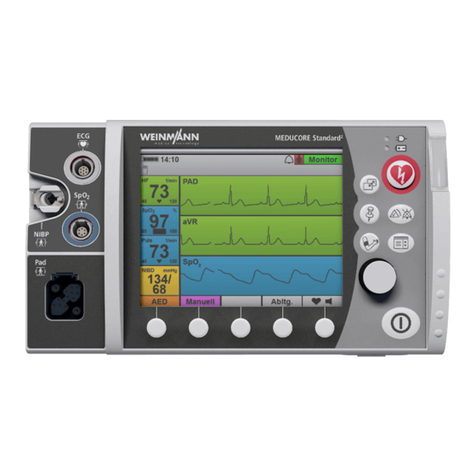
Weinmann
Weinmann MEDUCORE Standard2 Instructions for use

Ossur
Ossur MIAMI J Instructions for use
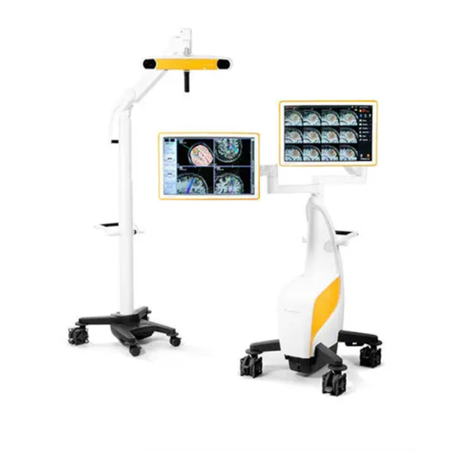
Brainlab
Brainlab CURVE System setup
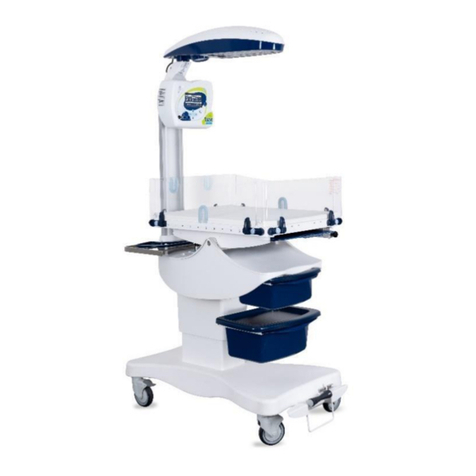
mediprema
mediprema AMBIA Usage Guide and Safety Reminders

Drive
Drive Folding bath bench with back Assembly instructions
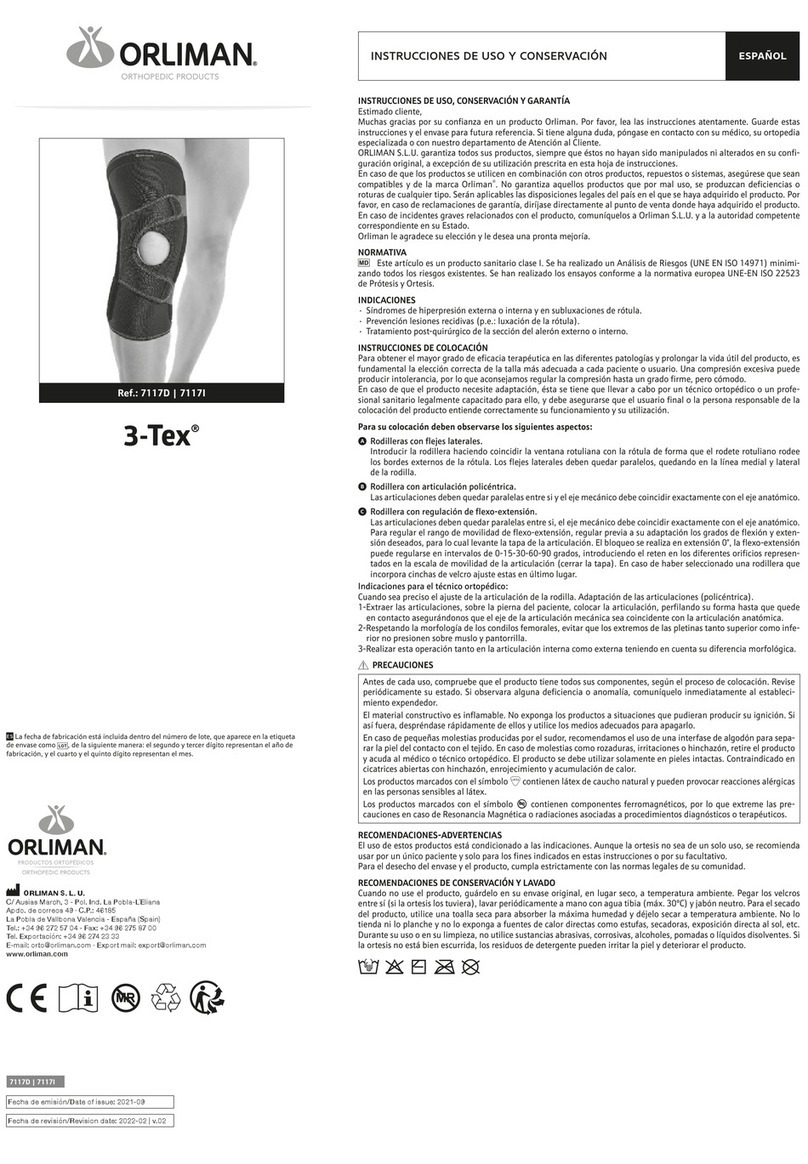
Orliman
Orliman 3-Tex 7117D Use and maintenance instructions
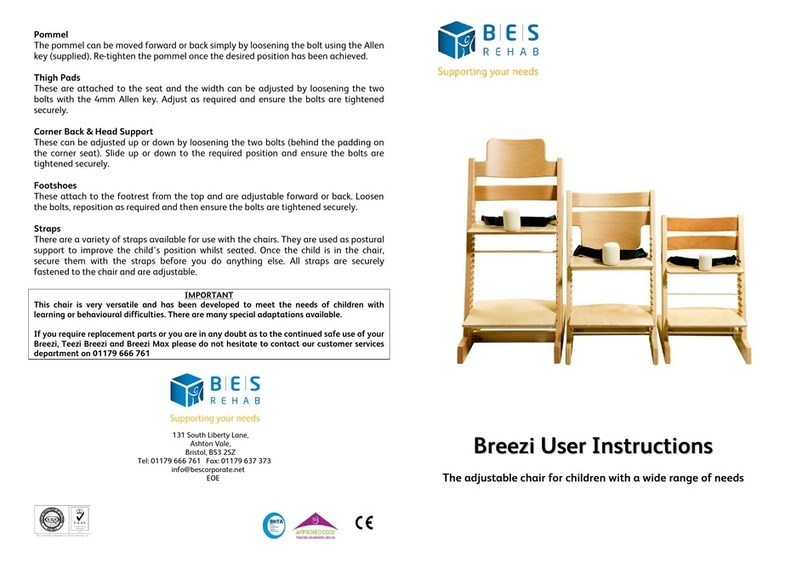
BES
BES Breezi User instructions
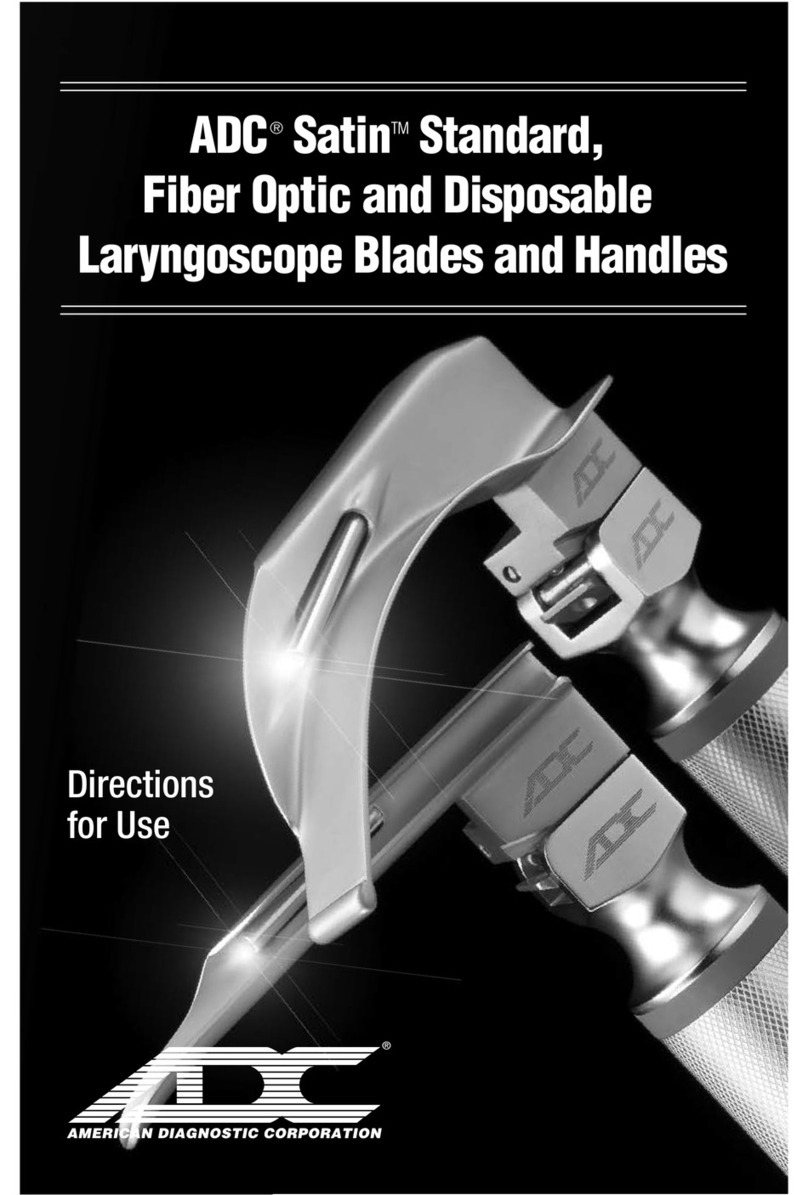
American Diagnostic Corporation
American Diagnostic Corporation Satin Directions for use
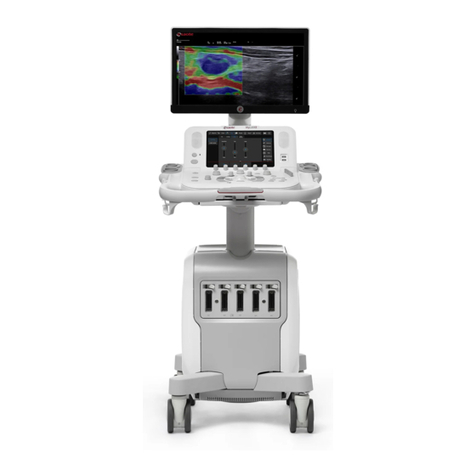
Esaote
Esaote MyLab X8 Quick reference guide

PHI
PHI HoloMonitor M4 Setup and operation manual
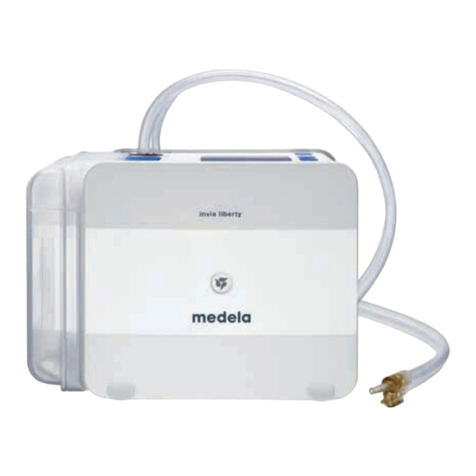
Medela
Medela Invia Liberty Clinician Instructions for Use
